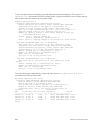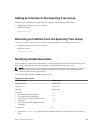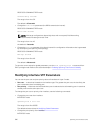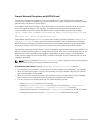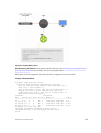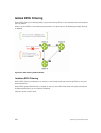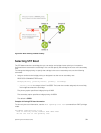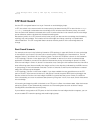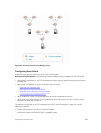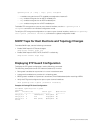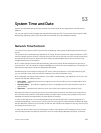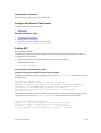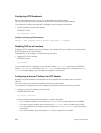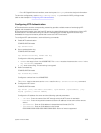
Root Bridge hello time 2, max age 20, forward delay 15
Dell#
STP Root Guard
Use the STP root guard feature in a Layer 2 network to avoid bridging loops.
In STP, the switch in the network with the lowest priority (as determined by STP or set with the bridge-
priority
command) is selected as the root bridge. If two switches have the same priority, the switch
with the lower MAC address is selected as the root. All other switches in the network use the root bridge
as the reference used to calculate the shortest forwarding path.
Because any switch in an STP network with a lower priority can become the root bridge, the forwarding
topology may not be stable. The location of the root bridge can change, resulting in unpredictable
network behavior. The STP root guard feature ensures that the position of the root bridge does not
change.
Root Guard Scenario
For example, as shown in the following illustration (STP topology 1, upper left) Switch A is the root bridge
in the network core. Switch C functions as an access switch connected to an external device. The link
between Switch C and Switch B is in a Blocking state. The flow of STP BPDUs is shown in the illustration.
In STP topology 2 (shown in the upper right), STP is enabled on device D on which a software bridge
application is started to connect to the network. Because the priority of the bridge in device D is lower
than the root bridge in Switch A, device D is elected as root, causing the link between Switches A and B to
enter a Blocking state. Network traffic then begins to flow in the directions indicated by the BPDU arrows
in the topology. If the links between Switches C and A or Switches C and B cannot handle the increased
traffic flow, frames may be dropped.
In STP topology 3 (shown in the lower middle), if you have enabled the root guard feature on the STP
port on Switch C that connects to device D, and device D sends a superior BPDU that would trigger the
election of device D as the new root bridge, the BPDU is ignored and the port on Switch C transitions
from a forwarding to a root-inconsistent state (shown by the green X icon). As a result, Switch A becomes
the root bridge.
All incoming and outgoing traffic is blocked on an STP port in a Root-Inconsistent state. After the timeout
period, the Switch C port automatically transitions to a Forwarding state as soon as device D stops
sending BPDUs that advertise a lower priority.
If you enable a root guard on all STP ports on the links where the root bridge should not appear, you can
ensure a stable STP network topology and avoid bridging loops.
922
Spanning Tree Protocol (STP)



